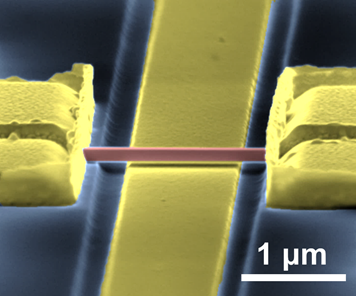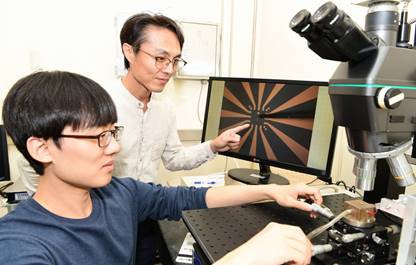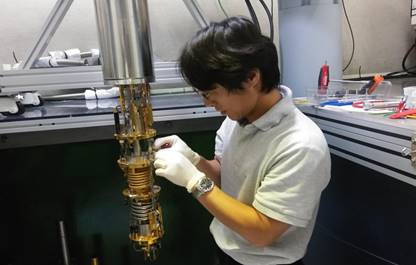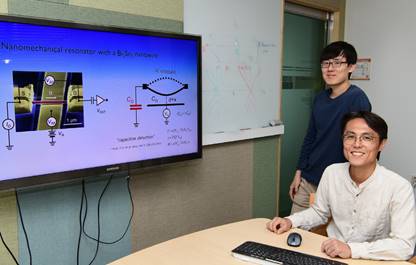
News & Updates
Bringing Nobel Prize-winning exotic matter from theory to reality
- Writerkrissadmin
- Date2019-10-22 00:00
- Hits12028
Bringing Nobel Prize-winning exotic matter from theory to reality
- Nanowire topological matter measurement technology to bring quantum device innovation -
# The Nobel Prize in Physics 2016 was awarded to David J. Thouless (University of Washington), J. Duncan Haldane (Princeton University), and Michael Kosterlitz (Brown University). They employed the mathematical concept of topology to explain the properties of certain materials originating from topological phases of materials. The materials have been known to exhibit exotic electronic properties different from those of ordinary insulators and semiconductors. Three years later, researchers from the Korea Research Institute of Standards and Science and the University of Cologne have developed a novel measurement technology to characterize the electronic properties of topological matter.
The team led by Dr. Junho Suh, principal research scientist at the KRISS Quantum Technology Institute, and Dr. Kun Woo Kim, researcher at the Institute for Basic Science (currently at the University of Cologne), have developed a measurement platform based on nanomechanical devices* to study the properties of topological matter. They fabricated a nanowire-based nanomechanical device made of a topological material and analyzed its resonance frequency. This measurement technology is the world’s first in the field of topological matter based nanomechanical device research and paves the way for applications of topological matters in quantum devices, the fundamental component of quantum computing and quantum telecommunications.
* Nanomechanical device
A nanoscale device which is manufactured by nanofabrication processes and uses mechanical vibrations in signal processing, sensing and other applications.
Topology had long been a field exclusive to mathematicians. In recent years, however, it has been gaining interest as a concept that could expand the field of physics, with discoveries on the topological state of matter being awarded with the Nobel Prize in Physics.
Topological matter, which exists in a topological state, is classified according to topological invariants, similar to the number of holes in objects. Take a ball made of clay. To turn this ball into a donut shape, a hole has to be punctured in the ball. In the world of topology, a ball without a hole and a donut with one hole are considered topologically different. By the same logic, although a ring appears to be different from a donut, they are considered topologically identical as they both have just one hole.
Electronic devices made of topological matter are expected to be used as quantum devices, with quantum coherence* protected by their topological properties. However, the interesting properties of topological matter have to be fully understood before it can be applied to the real world.
*Quantum coherence
A phenomenon in which the wave-like nature of quantum objects is preserved to show their interference or superposition. Decoherence is the opposite concept of coherence, wherein the wave-like quantum properties are disturbed by environmental noises. Topological states of matter are expected to be robust against decoherence.
The team produced a topological nanowire (approximately a hundred nanometer thick) based mechanical device, and successfully demonstrated a novel technique to measure electron density of states*, one of the important properties of topological matter. After growing a nanowire using bismuth selenide (Bi2Se3) compound, a topological insulator*, the nanowire was suspended over a metallic electrode separated by only tens of nanometers to induce and measure mechanical vibrations. The nanomechanical device resembles a guitar string, with the nanowire floating, fixed from its two ends. Just as a guitar string resonates when plucked, the nanowire also produces resonance, which can be used to reveal the topological properties of the material.
*Electron density of states
The number of electrons within a substance that can exist at a given level of energy
? *Topological insulator
A substance that has electronic structure with topological properties, with conduction occurring only at the surface of the solid, while insulation is maintained within.
At extremely low temperatures, the electrons on the surface of the nanowire maintain quantum coherence well. Researchers have successfully used this to measure the electrical properties of topological matter as well as changes in the resonance frequency depending on the density of state. They have also clearly demonstrated through theoretical calculations that these experimental results arose from quantum phenomena caused by interaction between the vibration of the nanowire and the surface electron system.
“It took decades of effort to understand the properties of semiconductor before the first electronic device, the transistor, was invented,” said Dr. Suh, explaining that “the mechanical resonance based measurement technology we developed is an important step in understanding the properties of topological matter, which can be used in future quantum devices such as qubit* and spintronics* devices.”
*Qubit
Unit of quantum data processing. While the digital ‘bit’ can be in the state of either '0' or '1', qubits can be in both 0 and 1 states, due to quantum state superposition, and are used as the basic computing unit for quantum information processing.
? *Spintronics
Electronic device technology using the spin of electrons. It can potentially be used to store much greater volumes of data compared to conventional semiconductor memories, and can process and store data simultaneously.
This study was funded by KRISS, the Institute for Basic Science, and the National Research Foundation of Korea and published in the international journal Nature Communications (IF: 11.878) in October
○ Images illustrating the study

▲ Topological matter based nanomechanical device used in the study. The fixed part in the center, which resembles a guitar string, is the nanowire, and the topological state was measured using the resonance of the nanowire.
○ What sets this research apart?
This study produced the world’s first findings in the field of topological matter based nanomechanical devices. The electron density of states on the surface of topological matter was probed through high precision measurements of the mechanical resonance in the system.
○ What are its applications?
Electrons within a topological material have features that can be used in future quantum electronic devices, such as the protection of quantum coherence or mutual control of charge and spin, arising from topological properties. Also, such topological properties may be utilized in the future for applications of nanomechanical devices such as signal processing and highly sensitive sensors.

▲ Dr. Junho Suh (back) and Postdoctoral researcher Dr. Jihwan Kim at the KRISS Quantum Technology Institute are performing an experiment on the nanomechanical device.

▲ Dr. Junho Suh is preparing an experiment on the nanomechanical device.

▲ Dr. Junho Suh(bottom) and Postdoctoral researcher Dr. Jihwan Kim(top) at the KRISS Quantum Technology Institute
QUICK MENU 원하시는 서비스를 클릭하세요!
등록된 퀵메뉴가 없습니다.
